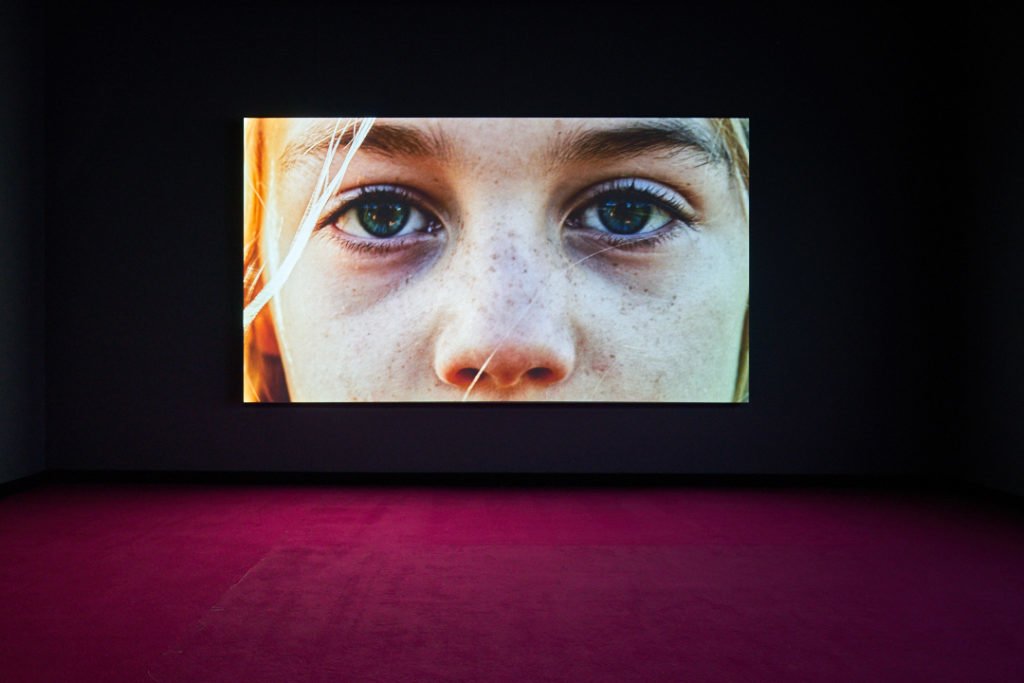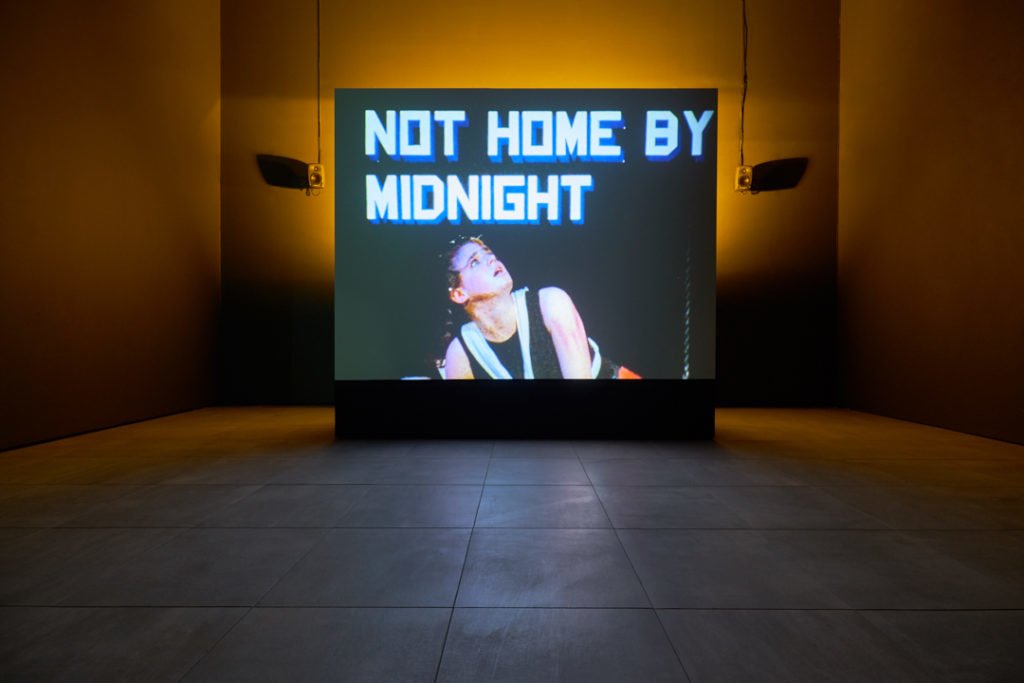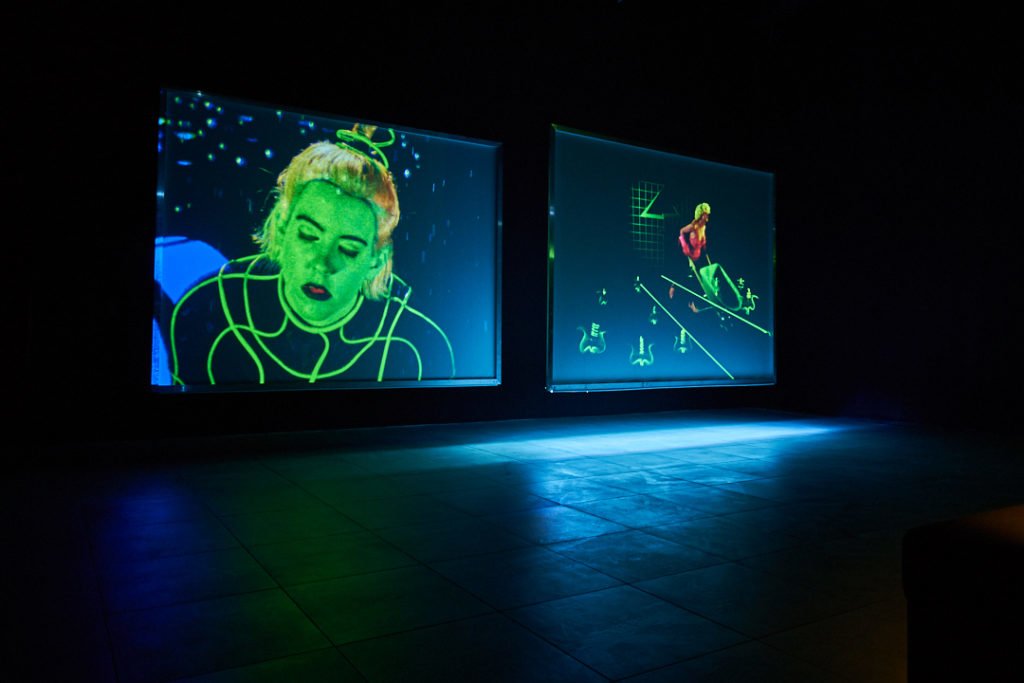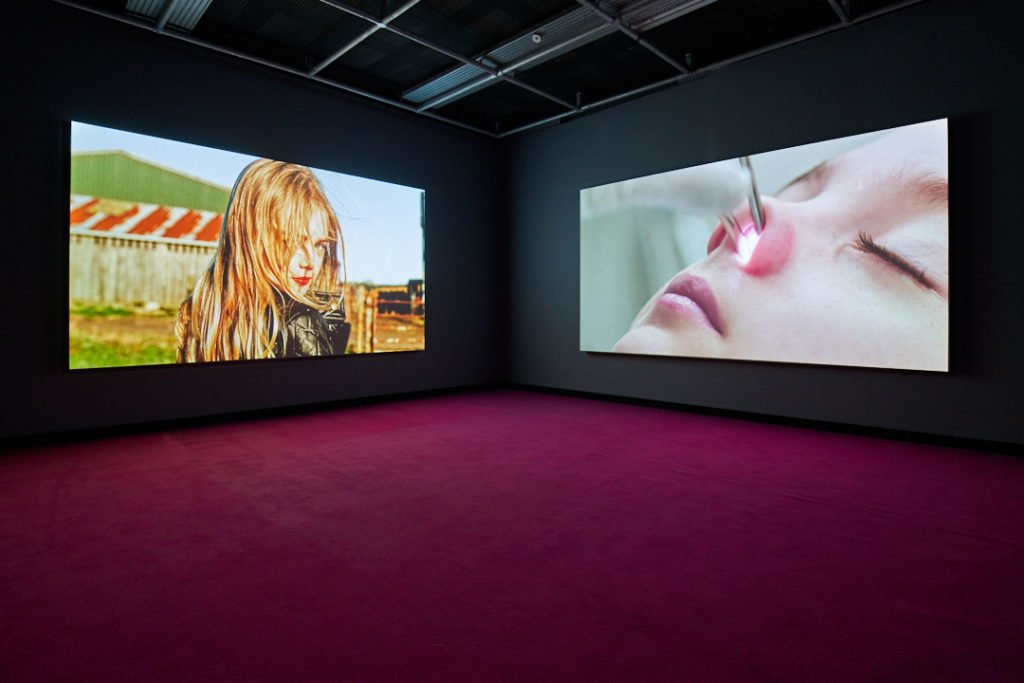
(c) Rob Battersby
If you have popped your head into FACT recently, or even glanced through the glass doors, a giant rainbow of colour and character will most likely have caught your eye. As a way to set out your stall for the year ahead, there is perhaps no better statement than Laura Callaghan’s mural, a wall sized painting which spans the full height of the atrium. On the opening night of FACT Liverpool’s new exhibition, this mural is like a joyful manifesto that seeps out across the assembled groups. DJ Cat Millar’s powder pink suit jacket could have been drawn onto her by Callaghan herself, as she controls the music for the evening. It’s not subtle, but this is not a time for politely asking if the glass slipper fits, when the heel is a weapon cracking every ceiling.
The fairy tale iconography we are used to is everywhere in the mural. Tiaras hang on the back of dressing table chairs and Snow White selects her apple. In the same space a woman in a creamy blue business suit breastfeeds as she runs the world through her phone, while another reclines and waits eagerly for the ‘cam-girls’ page to load. I can’t wait for this part of the fairy tale to be fully realised. This is an intersectional feminist wonderland. In this world you can have it all and it’s glorious.
Before I get carried away, perhaps it’s a good idea to back-track slightly. As I consolidate my thoughts around this exhibition, I think acknowledging my position in the mural is a good place to start. I am a white cisgender-woman, meaning my gender identity corresponds to my sex. To borrow a definition from Stonewall:
“Gender Identity: A person’s innate sense of their own gender, whether male, female or something else (non-binary), which may or may not correspond to the sex assigned at birth.”
This is a useful definition to keep in mind as the ‘Ericka Beckman / Marianna Simnett’ exhibition marks the beginning of FACT’s year-long study of feminism and representation. I look forward to seeing an institution embark on this challenge, and as a start, Callaghan’s mural is a good manifesto to work from. Gender is continually the basis for scrutiny, dismissal, and oppressive behaviours and laws globally. This includes everything from the Gender Pay Gap, to Trans-Exclusionary Radical Feminist (TERF) groups demeaning and denying the identities of transgender individuals. This fairy tale has not yet made it to the happy ending where princes, princesses and those who choose not to be defined as such can inhabit this world safely.
After basking in the saturated buzz of the busy Learning Space, I take my iridescent notebook into the darkness of the ground floor galleries. Ericka Beckman’s ‘Cinderella’ (1986) glows as the only video in the room. A female persona pumps a furnace with the rings of her bare-hooped skirt frame, in itself the signifier for each level of her subjugation from her waist down to her calves. Her body is the territory on which the contours of her manipulation are drawn. On the surface, the sing-song tone is beautifully lyrical.

(c) Rob Battersby
In the next room, ‘Haitus’ (1999/2015), set across two screens, asks us to shift between digital and physical gameplay, the object of which seems dispersed and unattainable. A female avatar’s power is drained and her agency ‘lassoed’ as the same rules continue to govern this landscape, the next evolution from the mass-produced expected female doll image in ‘Cinderella’. We are reminded that cyberspace is still a production at the expense of marginalised individuals, and this cannot be ignored in the popular conception of a utopian disembodied digital playground.
The characters in Beckman’s videos progress through time periods, fighting off domestic, industrial and cyberspace challenges, demonstrating that the game was always rigged. Presenting us with a timeline of looping power structures, Beckman suggests that breaking through and winning this cycle continues to be impossible. Perhaps the goal should be to change the game altogether.

(c) Rob Battersby
Emerging slightly dazed from Beckman’s dual-game reality, going upstairs to Marianna Simnett’s ‘Faint with Light’ (2016) is completely dazzling, and I mean that most literally. This is an installation best experienced first-hand, so I am not going to attempt to describe it here. I would advise reading the catalogue information afterwards, because it perfectly sums up the subversive and extremely physical approach Simnett applies in her practice.
Personally, Simnett’s videos have always been a challenge for me. I am anxiously squeamish. Being confronted with the fallibility of my body induces a level of sweaty panic that is difficult to suppress. This may explain my desire to escape the final room of the exhibition where ‘Blood’ (2015) and ‘The Udder’(2014) jut up against each other in an overwhelmingly claustrophobic assessment of female control, expected moral behaviour and anatomical symbolism.
This may be the point of placing the two videos in such close proximity, and I regret only being able to manage these works in small doses. Whereas Beckman’s imagery is grounded in the structures she is criticising, Simnett returns us to the original site of the trauma. The same young female actress plays out the roles imprinted and engrained on women. To clarify, this would be cis-women, based on the focus surrounding mammary glands and menstruation.

(c) Rob Battersby
The metaphor is intense between cows and milk, noses and blood, and the sickly pinkish hue given to games of bullying in order to maintain conformity. The hallmarks of impurity are pulled out from a young woman through surgery on her nasal passages, and the milk taken is processed and made consumable in the same way. This is the consequence of losing the game Beckman’s Cinderella is fighting. Perfectly filtered milk, the required outcome, is continually under threat from contamination and the hypocrisy of function versus desire. This is the fear and violence that still exists in the game.
If I had managed to maintain any of the hopefulness that Callaghan’s mural instilled, I was struggling to find it at this point.
Returning to the Learning Space for respite and a chance to re-compose myself, I was able to reflect on what the legacy of this exhibition could be. The take-away activity books encourage reflection on social media interactions, gender stereotypes and the way fairy tales can become a method to challenge expectations.
Activity 3, centring on the sworn virgins of Simnett’s ‘Blood’ (2015) video, asks “what would you give up to achieve your biggest dream?” This feels at odds with the vision of Callaghan’s mural.
This is not the only difficulty I have, as the focus of these activities seems to be around a binary man/woman dichotomy of relationships and behaviours that doesn’t open up space for gender non-conforming individuals. Furthermore, all three artists in the exhibition are white cis-women. Representation of identity as a curatorial focus means you have to represent. Especially when the entrance to your building is emblazoned by a mural with non-binary and ethnically diverse womxn. To only include the most societally privileged in this group to exhibit is not fulfilling your aims or what is needed. I am hopeful that this is addressed in the coming shows this year.
There is an extensive engagement programme, ranging from curator tours to reading groups, which I strongly recommend checking out on the FACT website. The Learning Space is set to become a hub where conversations around gender identity and feminism can flourish. That is precisely what exhibitions like this need to inspire if we want to progress beyond the realities Ericka Beckman and Marianna Simnett reflect and examine.
GROUPS IN LIVERPOOL TO CHECK OUT FOR SUPPORT / EDUCATION / ACTIVISM (by no means an exhaustive list)
GRRRL POWER – https://www.instagram.com/grrrlpowerliverpool/
Root-Ed Zine – https://www.rootedzine.co.uk/
Liverpool Queer Collective – https://liverpoolqueercollective.co.uk/
Where are the girlbands? – https://www.instagram.com/wherearethegirlbands/
Merseyside LGBT Social Group – https://www.meetup.com/MERSEYSIDE-LGBT-SOCIAL-GROUP/
Filed under: Art & Photography
Tagged with: contemporary art, digital, Ericka Beckman, FACT, fairytale, film, gameplay, games, Laura Callaghan, Marianna Simnett, mural, video



Comments